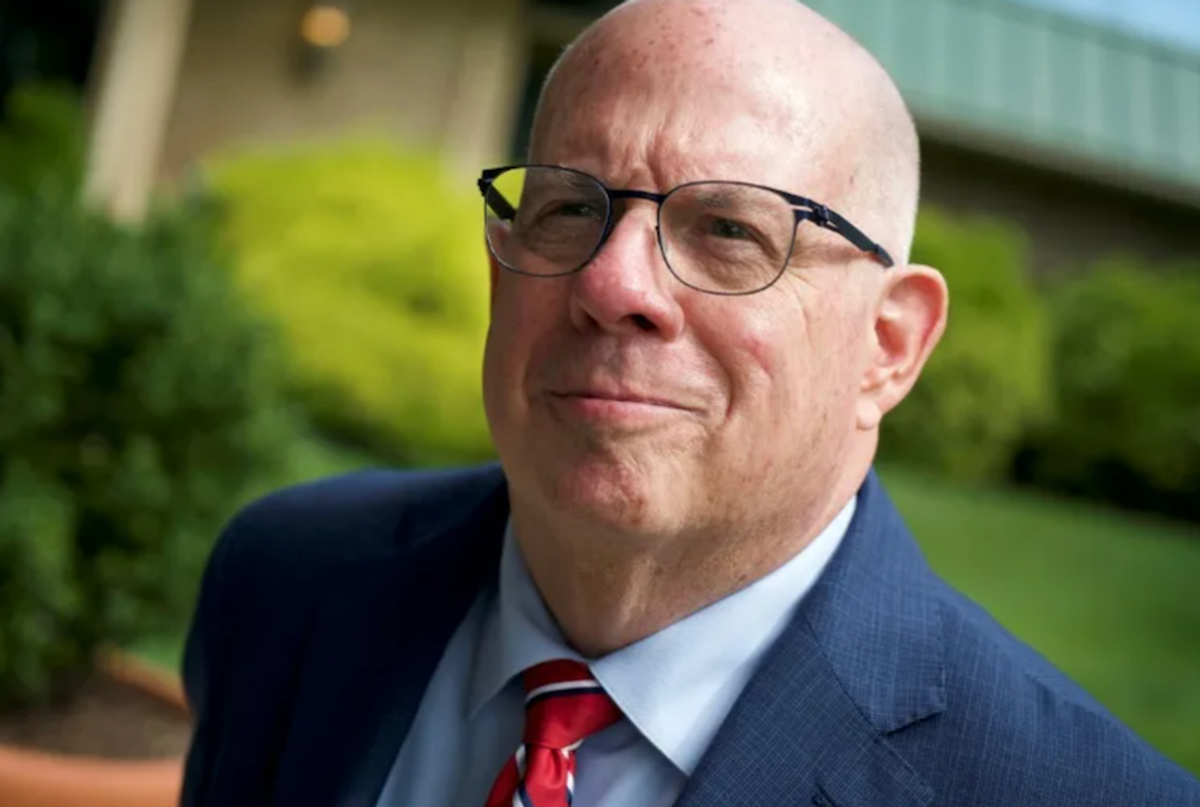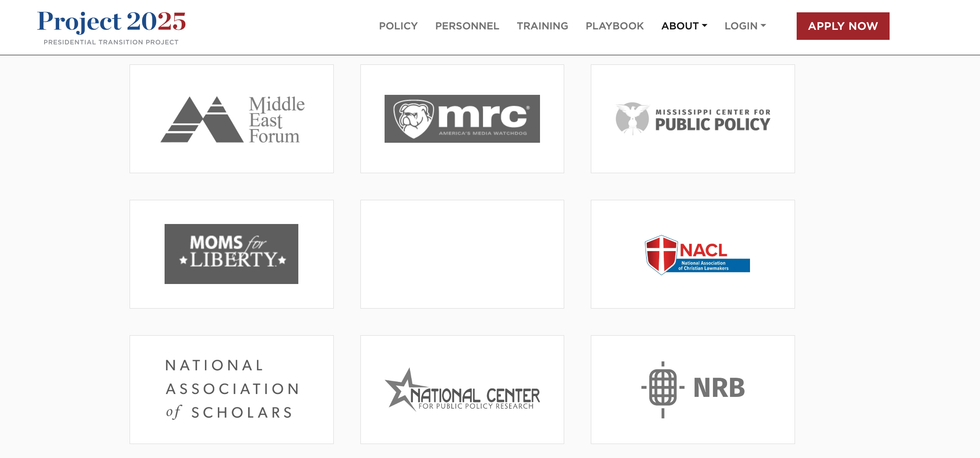October 3, 2024

Republican U.S. Senate hopeful Larry Hogan, former governor of Maryland (Bastien INZAURRALDE/AFP)
This article was paid for by Raw Story subscribers.
As wealthy Republican donors funnel millions into Larry Hogan's U.S. Senate campaign, the former governor of Maryland has distanced himself from former President Donald Trump and the controversial conservative “presidential transition” plan, Project 2025.
Yet, according to a Raw Story analysis of federal financial records, Hogan’s campaign has still benefited from donations from billionaire Trump supporters and individuals working at organizations involved with Project 2025.
Hogan is running in a surprisingly competitive race in what’s typically solidly blue Maryland against Democrat Angela Alsobrooks. Last week, a poll from the Washington Post and the University of Maryland shows Alsobrooks, a Prince George’s County executive, with a double-digit lead over Hogan, who was previously heavily favored by voters in a March poll.
The Republican presidential nominee endorsed Hogan in June, but Hogan confirmed in an interview with CBS’s “Face the Nation” on Sunday that he would not be voting for Trump, whom he said he didn’t vote for in 2016 or 2020 either.
“I’ve said for years that Trump’s divisive rhetoric is something that we could do without. I think he’s his own worst enemy,” Hogan said in the interview with Robert Costa.
Hogan also has taken to blasting the Heritage Foundation's Project 2025, which calls for curtailing abortion access, increasing deportations, eliminating government agencies like the Department of Education and banning transgender athletes from sports as part of a plan for a conservative presidency.
In a Washington Post op-ed, Hogan said Project 2025 “shreds American values” and said calling its ideas “radical” is a “disservice.” In campaign communications, Hogan said codifying Roe v. Wade, the Supreme Court decision protecting the right to abortion, and leading the “fight against Project 2025” were part of his top five commitments.
Trump has disavowed Project 2025, but his running mate, Sen. J.D. Vance (R-OH), has close ties with the Heritage Foundation and its founder, Forbes reported. According to CNN, more than 140 former Trump administration officials were involved in its creation.
Blake Kernen, a spokeswoman for Hogan’s campaign, did not answer Raw Story’s questions about donations from individuals whose employers were cited as being involved with Project 2025.
“Governor Hogan’s only ‘role’ in Project 2025 is being the leading Republican in America to oppose it, and he is fully committed to fighting against it in Congress,” Kernen told Raw Story via email.
Kernen did not respond to Raw Story’s questions about Trump megadonors contributing to fundraising committees benefitting Hogan’s campaign.
Trump billionaire donors support Hogan
Maryland’s Future, a super PAC supporting Hogan, has received donations of more than $100,000 – and as much as $10 million — from 12 wealthy Republican donors, some of whom support Trump, according to The Washington Post.
The PAC is spending $18.3 million on TV ads during the last six weeks of the Hogan-Alsobrooks race, according to The Washington Post.
According to a Raw Story review of records from the Federal Election Commission, at least three of the top 26 billionaire donors to Trump (as reported by Forbes) have also contributed to Hogan’s campaign.
Republican megadonor Kenneth Griffin, CEO of the hedge fund Citadel, donated the most to Maryland's Future PAC: $10 million. According to Federal Election Commission filings, he also contributed $6,600 to Hogan for Maryland, Hogan's principal campaign committee.
Fortune reported that Griffin has not donated to Trump’s campaign but reportedly met with him in July about financing his presidential campaign.
Blackstone CEO Stephen Schwarzman and his wife, Christine Schwarzman, donated $2 million to Maryland's Future and $6,600 each to Hogan for Maryland. Schwarzman contributed $419,600 to a joint fundraising committee supporting Trump, according to The Washington Post.
Warren Stephens, CEO of the private investment bank Stephens, Inc., gave $1 million to Maryland's Future and $6,600 to Hogan for Maryland, according to the Federal Election Commission. He also donated $2 million to the Make America Great Again Inc. super PAC and $250,000 to another pro-Trump fundraising committee, according to The Washington Post.
As for other Trump megadonors, Linda McMahon, the wife of Vince McMahon, the World Wrestling Entertainment mogul under investigation for sex trafficking, has donated $16 million to Trump campaign committees, according to Forbes.
According to Federal Election Commission records, she also donated $6,600 to Hogan for Maryland.
McMahon is chair of the board and chair of the Center for the American Worker for the America First Policy Institute, a conservative nonprofit think tank founded in 2021 to promote Trump's public policy agenda.
Carla Sands, former Trump administration ambassador to Denmark, is also involved with the America First Policy Institute as vice chair for the Center for Energy and Environment. Sands is credited with contributing to Project 2025, noting her affiliation with the America First Policy Institute.

Screen grab from Project 2025 document crediting Carla Sands and Justin Schwab (https://static.project2025.org/2025_MandateForLead...)
Marc Lotter, chief communications officer for the America First Policy Institute, told Raw Story via email that the nonprofit “does not endorse any candidates” and is “not in any way affiliated with Project 2025.”
“Ambassador Sands' work occurred in her personal capacity and should have been reflected as such. At no time was AFPI aware of her participation, nor was she authorized to use her AFPI affiliation," Lotter said.
Lotter added, “Ms. McMahon was not aware nor involved in Ambassador Sands's personal work. The use of her AFPI affiliation was not authorized.”
Kelsy Warren, CEO of oil company Energy Transfer Partners, has donated nearly $6 million to Trump’s campaign, according to Forbes. He has also donated $6,600 to Hogan for Maryland, according to the Federal Election Commission.
Steve Wynn, a real estate developer who created notable Las Vegas casinos and hotels but stepped down due to sexual assault allegations he denies, has given Trump campaign groups $1.1 million, according to Forbes. He and his wife, Andrea Wynn, each gave $6,600 to Hogan for Maryland, according to the Federal Election Commission.
Project 2025 questions
While Hogan maintains his condemnation of Project 2025, he previously appointed Robert Moffit, a senior fellow in the Heritage Foundation's Center for Health Policy Studies, as chairman of the Maryland Health Care Commission while serving as governor of Maryland.
Kernen did not respond to Raw Story’s questions about whether Hogan stands by Moffit’s 2017 appointment.
In the 900-page Project 2025 document, two individuals who worked with CGCN, an all-Republican lobbying firm, and its separate law firm, are credited as contributors: Aaron Szabo, now a government and regulatory affairs attorney with Faegre Drinker, and Justin Schwab, founder of CGCN law.
According to his candidate financial disclosure filed with the U.S. Senate in April, Hogan worked with CGCN as a consultant. His campaign manager, David Weinman, was also a former senior vice president with CGCN.
Hogan’s involvement with CGCN was “limited to consulting in support of President Biden’s cancer moonshot initiative,” Kernen told Raw Story. Weinman did not work on Project 2025, according to the campaign.
Hogan did not work with Szabo or Schwab and CGCN Law, according to the Hogan campaign.
Szabo and Schwab did not respond to Raw Story’s request for comment.
Shane Jackson, president of Jackson Healthcare and board member for the Foundation for Government Accountability, gave Hogan for Maryland, $3,300. The Foundation for Government Accountability, a conservative public policy think tank, is credited as being part of the advisory board for Project 2025.
The Foundation for Government Accountability and Jackson did not respond to Raw Story’s request for comment.
Two executive committee members of the Middle East Forum each contributed to the Hogan for Maryland committee. The Middle East Forum, a conservative nonprofit think tank focused on promoting "American interests in the Middle East" and protecting "the West from Middle Eastern threats," is credited as part of the advisory board on the Project 2025 website.
Executive committee member Nordahl Brue contributed $2,000 to Hogan for Maryland, and another committee member, Joshua Katzen, contributed $500.
“As a nonprofit organization, the Middle East Forum does not endorse political candidates or campaigns. Our policies and operations are guided by our mission, not by the personal political activities of individuals associated with our organization,” Gregg Roman, chief operating officer for the Middle East Forum, told Raw Story via email.

Screen grab of Project 2025 advisory board website page showing Middle East Forum credited (https://www.project2025.org/about/advisory-board/)
Roman referred questions about “individual donations or personal involvement in political projects” to the specific individuals. Brue and Katzen could not be reached for comment.
Roman did not respond to Raw Story's questions about the nature of the Middle East Forum's involvement with Project 2025.
Alexandria Jacobson is a Chicago-based investigative reporter at Raw Story, focusing on money in politics, government accountability and electoral politics. Prior to joining Raw Story in 2023, Alex reported extensively on social justice, business and tech issues for several news outlets, including ABC News, the Chicago Sun-Times and the Chicago Tribune. She can be reached at alexandria@rawstory.com. More about Alexandria Jacobson.


